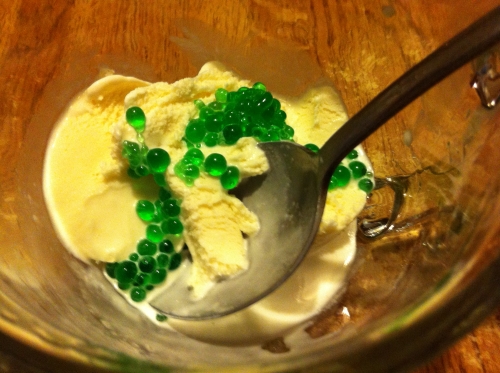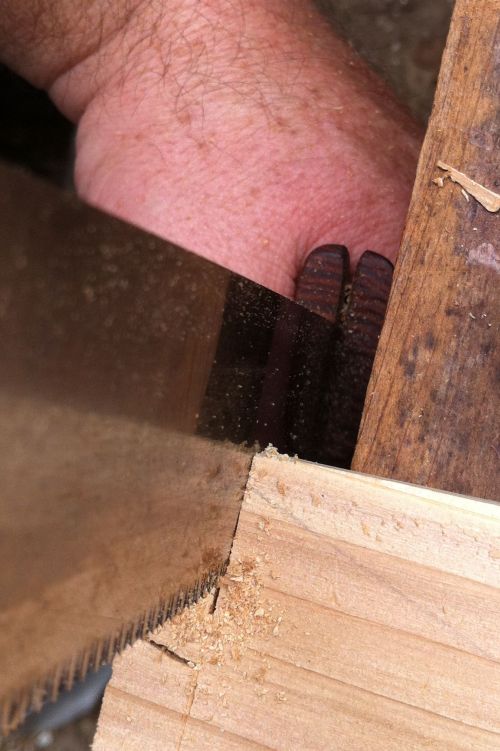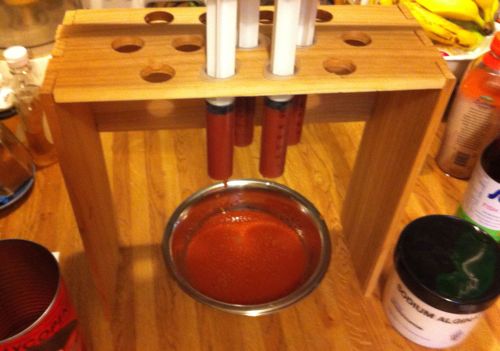
Creme De Menthe Caviar on Haagen Dazs Vanilla Ice Creme
Sometimes you need to do molecular gastronomy, and you need to do it now!
Spherification is a rather nifty process where you react juice with sodium alginate in it and a calcium containing fluid to make little juice filled gelatin balls.
While adding sodium anything to your diet should always be questioned, sodium alginate has been shown to help lower retention and absorption of lead, mercury, and some other bad stuff. Depending on your situation a little bit every now and then might be quite good for you. The entire reason I am doing this is to reduce the effect of some of my past exposure to lead and mercury. I have been a technician for a long time and have ample opportunity for exposure.
There are reasons to fear sodium alginate and reasons to want sodium alginate in your diet. Spherification is one way to get a small amount every now and then.
The basic method of spherification is to drop drips of sodium alginate bearing juice into a bath of calcium chloride. To make a lot of them quickly you need to be able to make a lot of drops quickly. One method is to make a spherification rack.
I needed it done within an hour, so I grabbed some wood that was handy and the right thickness. This particular cedar was a bit prone to splitting, so it has sat there for a while with no purpose, just because it was very pretty wood. Since this project is not going to do any serious load bearing, and it was handy, I grabbed this wood.
So I square my bevel with a 1-2-3 square. It tool longer to set up the camera than it took to square the bevel.
I use another board end and the bevel gauge to draw a base line on all the boards that I will dovetail. I mark with a pencil and with a striking knife. Then I mark dovetails and put squiggles in the area I am going to remove so I don’t make a mistake.
While I am showing methods of preventing splitting, I’m not going to actually teach how to make dovetails here, Paul Sellars does a better job of that than I ever could.
Learn Quick Dovetail Techniques with Paul Sellers
Here I come in with my carving gauge to make the lines a bit deeper where I am going to remove wood. This helps reduce tear out and splitting. I made the holes first using a 1″ forstner. The holes where laid out on a two inch center using a divider/compass to mark intersections.
I use two carving gauges, so that I can limit the cutting action in either direction.
I also like to define the end of a cut. This can reduce splitting.
In the image below, the saw cuts when being pulled down. No deep gouges are needed on this side to prevent tearout and splitting. The other side can get nasty however without a well struck line. This is a method for cutting dovetails without using a vise. In the case of this quick job, I was more concerned with speed than precision, so I didn’t even bother with using a vise.
Sawing lots of slits into the waste can also reduce the chance of tearout on split prone wood.
It is possible to remove waste by using just the carving gauge.
With wood this thick, a key hole saw is going to be a faster method.
The holes are drilled all the way through. I just haven’t punched out the biscuits yet. I drilled through until the point of the drill came out on the other side, and then I used that to center the drill and drill in from the other side. This is another good method to prevent split prone wood from tearing out.
With the project finished, I was able to complete testing on time.
I didn’t even clean up the edges on the finished rack. No glue, just a good combination of dovetails holding it all together.
With a board on top and gentle pressure, I was able to make a lot of ‘caviar’ quickly.
This rack has room to expand and it comes apart easily for storage. It does the job so well, that I am going to be putting up with this rush job for a long time.
My initial test told me that the rush was unnecessary, the flavor had a rather unpleasant tone that needed adjustment. So I did a bit more research.
First off, the recipes and methods out there on the web are for the most part ornamental and hardly gourmet. Seriously, there are better ways to do basic spherification.
The first thing to do is to replace the calcium chloride bath entirely. It makes the taste bitter/chalky and does nothing for you nutritionally. If you need to settle your stomach then maybe, but not if you want a delightful flavor. Calcium lactate barely has a flavor, and can be good for your teeth. It makes a much better caviar developing bath.
The second thing to do is to reduce the concentrations of the chemicals so you are working more with the initial flavors and less with the additional materials. The recipes out on the web are for the most part using way higher concentrations than are needed. The basic recipe that I give below may still be way more than what is needed.
First I premix a cup of distilled water with a gram of sodium alginate, and get a fairly thick syrup. I make this part ahead of time and keep it in the refrigerator.
When I am ready to make a batch of juice caviar, I put three tablespoons of juice in a cup and then stir one tablespoon of the premixed sodium alginate.
Then I make the caviar developing bath by mixing 15 grams of calcium lactate with three cups of water. This fills the bowl I use nicely. I have a stainless steel strainer and bowl combination that fit together perfectly so I can leave the strainer in the bowl while the caviar develops.
Here is the process, a drop falls from the food grade syringe, and falls into the bath below. The sodium alginate reacts to the calcium and cross links into an elastic shell. After 30 seconds to a minute, the caviar is ready to be lifted out so it does not immediately become gel all the way through.
As it sets the flavor is muted. If you have tasted jello juice before it sets, it is a much stronger flavor than after it turns to gel. The same is true here. So for the intense burst of flavor you need two things, the center to stay liquid and the flavor of the juice to be intense!
So My droppers run frantically for 30 seconds, I wait 15 seconds longer and then start to drain the caviar by lifting the strainer out of the bath. The strainer takes about 20 seconds to drain and then I lower it into a cold water bath to rinse off the developing fluid.
The next important step is to serve immediately!
A blend of amaretto, creme de coco and orange curacao makes an extraordinary burst of flavor!
Mixing in a few beads with raspberry syrup in with the liquor blend is also quite a joy!
Bob















 A page Dedicated to My Writing
A page Dedicated to My Writing
Recent Comments